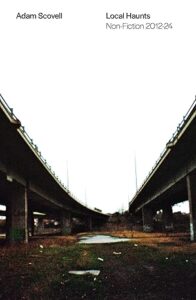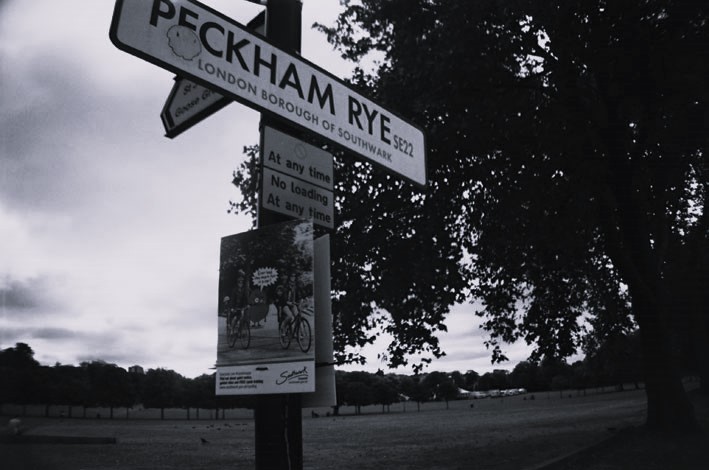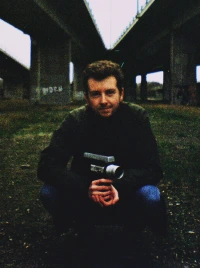Book Review – April 2025
Cities become film sets. Streets become libraries. Fantasy and reality blur.

Adam Scovell is a writer, film-maker and the author of three novels: Mothlight, How Pale the Winter Has Made Us and Nettles, all previously reviewed on this blog. Scovell also published one of the key texts examining the phenomenon of ‘wyrd’ film and television with his Folk Horror: Hours Dreadful And Things Strange in 2017.
Local Haunts brings together a collection of essays by Scovell from the period 2012 to 2024. These were previously published in The Nightjar, Fourth Estate, The Quietus, Caught By The River, Literary Hub, Port Magazine, Little White Lies, British Film Institute and Sight & Sound, as well as Scovell’s own Celluloid Wicker Man blog. The sheer output and sustained quality of Scovell’s work, while at the same time making short films, completing a PhD and writing three novels, is breathtaking. The book comprises three main sections: Literature, Wanders and Film & Television, though there is inevitably much crossover of artists and subjects between the three sections. If there is any single theme encompassing Scovell’s collection of essays it is that of wandering: spatial, temporal, creative and imaginative wanderings
Literature considers the works of writers for whom a sense of place is an integral part of their creative process. M.R. James, W.G. Sebald and Marguerite Duras feature prominently in this section, as indeed they do in the subsequent two sections. But it is not just the influence of landscape on the work of these and other writers, it is the way place becomes an expression of the artist’s inner feelings and experiences. In the case of James, for instance, Scovell shows how the places he describes betray his inner solitude, trauma and sorrow.
The Wanderings section of Local Haunts is illustrated throughout with Scovell’s atmospheric Polaroid pictures, each one a ghostly reimagining of a place visited, places that are significant to the writers and film makers that have inspired his own work. We are taken to, among many other places, Angela Carter’s Clapham, Stanley Kubrick’s Thamesmead and Muriel Spark’s Peckham.

Some wanderings require Scovell to visit far-flung parts of Great Britain, other journeys take him to continental Europe, France in particular. However, the birthplace of one favourite author, Anita Brookner, he discovers on his doorstep in Herne Hill in a house he walked past ‘on an almost daily basis’.
Herne Hill typifies Brookner for a number of reasons. Her work is neat, suburban and yet also contains a calculated sense of social status and style; very much typical of the area. Often, Brookner is likened to the protagonists of her novels: equally calculated, prim and lonely. Yet most consider this image to be in part a concoction, a veil through which to dodge the increasing barbs that a phenomenal success such as hers brings.
Like this present blog in 2012, and no doubt many other writers and critics, Scovell sets out to map the journey around Paris made by the protagonist in Agnès Varda’s 1962 film Cléo From 5 to 7.
The film is framed a woman walking, following in the footsteps of the mournful title character as she travels across Paris, all captured with intense geographical detail, in fact, that a book-length essay would be worthier to cover the sheer number of interesting references to buildings, clothes, cars, objects, people, antiques and other paraphernalia that appears on screen.
Local Haunts‘ third section groups together a selection of articles under the heading Film & Television, the area of interest where, for many of us, Adam Scovell first made his name as an innovative and insightful writer. He casts a considered eye over works as varied as Michelangelo Antonioni’s Zabriskie Point (1970), Jacques Rivette’s Le Pont du Nord (1981) and Mike Leigh’s Nuts in May (1976). Almost invariably each of Scovell’s essays presents the reader with original insights that make one want to go and watch the film or television programme again, even if one has done so several times already.
Local Haunts is a work that is rigorously researched and cogently argued enough to satisfy those readers who may have specialist knowledge of Scovell’s field of interest. But he also shows he has the ability to write in a way that makes this collection very readable and accessible to the general reader.
 Adam Scovell is a writer and filmmaker from Merseyside, now living in London. He completed his PhD in Music at Goldsmiths University in 2018, and now writes regularly for the BBC, the BFI and many other outlets. He is the author of Folk Horror: Hours Dreadful and Things Strange (2017, Auteur), alongside three novels all published by Influx Press.
Adam Scovell is a writer and filmmaker from Merseyside, now living in London. He completed his PhD in Music at Goldsmiths University in 2018, and now writes regularly for the BBC, the BFI and many other outlets. He is the author of Folk Horror: Hours Dreadful and Things Strange (2017, Auteur), alongside three novels all published by Influx Press.
Local Haunts: Non-Fiction 2012-24
Adam Scovell
Influx Press
April 2025
UK – £11.99 (ebook), £11.99 (paperback)

Oh, that’s interesting – I always think of Brookner’s world being the mansion flats on the Euston Road and in Swiss Cottage. Picking one very obscure point out of your review – sorry!
The Brookner/Herne Hill essay was one of the best in the collection, in my opinion, and she’s certainly one of my favourite writers. You’re right though, Brookner’s characters never seem to live south of the river!